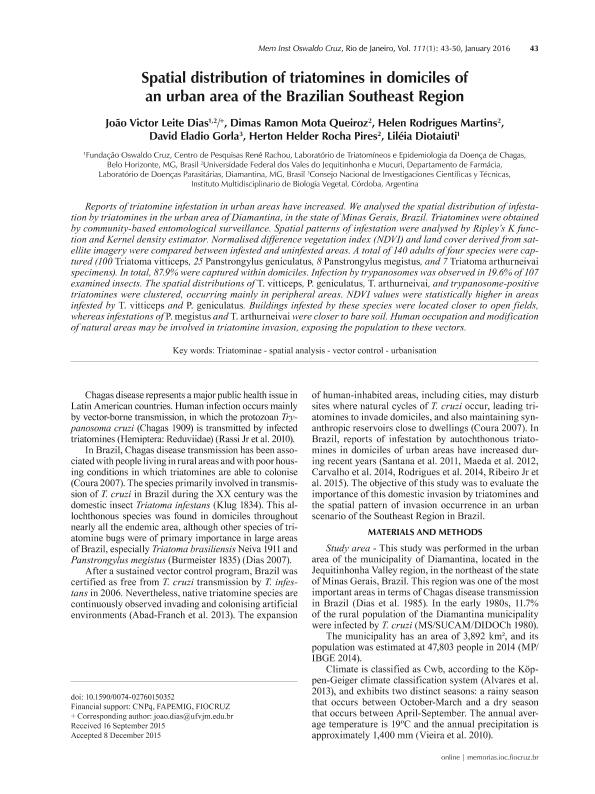Artículo
Spatial distribution of triatomines in domiciles of an urban area of the Brazilian Southeast Region
Dias, João Victor Leite; Queiroz, Dimas Ramon Mota; Martins, Helen Rodrigues; Gorla, David Eladio ; Pires, Herton Helder Rocha; Diotaiuti, Liléia
; Pires, Herton Helder Rocha; Diotaiuti, Liléia
 ; Pires, Herton Helder Rocha; Diotaiuti, Liléia
; Pires, Herton Helder Rocha; Diotaiuti, Liléia
Fecha de publicación:
01/2016
Editorial:
Fundacao Oswaldo Cruz
Revista:
Memórias Do Instituto Oswaldo Cruz
ISSN:
0074-0276
e-ISSN:
1678-8060
Idioma:
Inglés
Tipo de recurso:
Artículo publicado
Clasificación temática:
Resumen
Reports of triatomine infestation in urban areas have increased. We analysed the spatial distribution of infesta-tion by triatomines in the urban area of Diamantina, in the state of Minas Gerais, Brazil. Triatomines were obtainedby community-based entomological surveillance. Spatial patterns of infestation were analysed by Ripley?s K func-tion and Kernel density estimator. Normalised difference vegetation index (NDVI) and land cover derived from sat-ellite imagery were compared between infested and uninfested areas. A total of 140 adults of four species were cap-tured (100 Triatoma vitticeps, 25 Panstrongylus geniculatus, 8 Panstrongylus megistus, and 7 Triatoma arthurneivaispecimens). In total, 87.9% were captured within domiciles. Infection by trypanosomes was observed in 19.6% of 107examined insects. The spatial distributions of T. vitticeps, P. geniculatus, T. arthurneivai, and trypanosome-positivetriatomines were clustered, occurring mainly in peripheral areas. NDVI values were statistically higher in areasinfested by T. vitticeps and P. geniculatus. Buildings infested by these species were located closer to open fields,whereas infestations of P. megistus and T. arthurneivai were closer to bare soil. Human occupation and modificationof natural areas may be involved in triatomine invasion, exposing the population to these vectors.
Palabras clave:
Triatominae
,
Spatial Analysis
,
Vector Control
,
Urbanisation
Archivos asociados
Licencia
Identificadores
Colecciones
Articulos(IMBIV)
Articulos de INST.MULTIDISCIPL.DE BIOLOGIA VEGETAL (P)
Articulos de INST.MULTIDISCIPL.DE BIOLOGIA VEGETAL (P)
Citación
Dias, João Victor Leite; Queiroz, Dimas Ramon Mota; Martins, Helen Rodrigues; Gorla, David Eladio; Pires, Herton Helder Rocha; et al.; Spatial distribution of triatomines in domiciles of an urban area of the Brazilian Southeast Region; Fundacao Oswaldo Cruz; Memórias Do Instituto Oswaldo Cruz; 111; 1; 1-2016; 43-50
Compartir
Altmétricas



